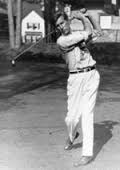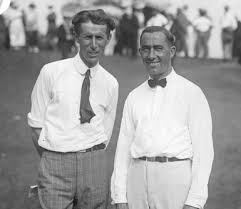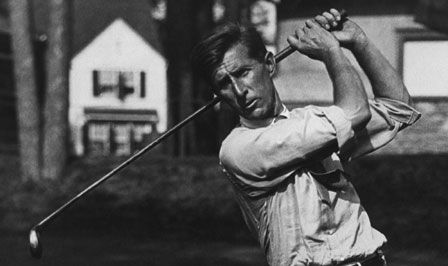JIM BARNES: ONE OF GOLF’S GREAT ANGLO-AMERICAN CHAMPIONS
The Winner of the First Two PGAs: 1916 & 1919
By Mike May
As the world of men’s professional golf looks forward to this year’s first two majors, it gives us a chance to reflect on the man who won the first two PGAs (in 1916 and 1919), yet never won or even played in the Masters – England’s Jim Barnes. This year marks the 100th anniversary of the second PGA victory by Barnes, who also won a U.S. Open (1921) and an Open Championship (1925) during his long and distinguished career that generated 28 tournament wins, 21 of which are categorized as official PGA Tour victories. Those four major championship titles put Barnes on the list of 17 golfers who have won at least three of golf’s four professional majors in their careers. In addition to Barnes, that list includes Jack Nicklaus, Ben Hogan, Tiger Woods, Gary Player, Gene Sarazen, Walter Hagen, Tommy Armour, Sam Snead, Byron Nelson, Arnold Palmer, Tom Watson, Raymond Floyd, Lee Trevino, Phil Mickelson, Jordan Spieth, and Rory McIlroy. It’s fair to say that Barnes, who was an inaugural inductee into the PGA of America Hall of Fame in 1940 and then the World Golf Hall of Fame in 1989, is probably the least well known player on that list of great golfers, but is very worthy of being a member of that special club. Author Elliot Kalb’s 2006 book Jim Barnes: The Forgotten Champion confirms that observation, as does a 2016 story by writer Peter Gompertz who wrote about “the neglected career of a golf champion.” That, of course, being Jim Barnes.
Barnes — who stood 6-foot-4 and was known as both “Long” and “Gentleman” Jim Barnes — could certainly play golf very well and did so for a number of years.

It can also be argued that Barnes deserves to be a member of the career Grand Slam circle of major championship winners – which includes Sarazen, Hogan, Nicklaus, Player, and Woods — because he won three Western Opens (1914, 1917, and 19191) and three North and South Opens (1916 and 1919), both of which were considered a ‘major’ before the creation of the Masters. It’s worth noting that while Barnes never played in the Masters, it wasn’t because he was excluded. He actually was invited to play in the first Masters tournament, but declined to accept the invitation. There’s no official reason why he chose not to travel to Augusta for that inaugural event which was officially known as the Augusta National Invitational Tournament — held in March 1934. Barnes may not have accepted the invitation because of his age – 47 at the time of the event, just a few weeks shy of his 48th birthday. Official records indicate that the last professional major that Barnes played was the 1932 U.S. Open where he finished 55th. Barnes did play in the 1930 (British) Open Championship, at age 44, where he recorded a sixth-place finish. And, he won the New Jersey State Open in 1939, when he was 53.
Had Barnes played in the Masters and won, he would have been the world’s first professional golfer to win the career Grand Slam. Instead, by not playing and not winning the Masters, Barnes finds himself on the aforementioned list of the 17 golfers who have won at least three of the four majors in their competitive careers.
It’s worth noting that when Barnes won his only U.S. Open in 1921, his winning margin was a record nine shots, which was unsurpassed until Woods won the 2000 U.S. Open by 15 shots. In his career, Barnes also had eight consecutive top-ten performances in majors from the 1919 PGA at Engineers Country Club (Roslyn Harbor, New York) to the 1922 Open Championship at Royal St. George’s Golf Club (England); he made the cut in 27 consecutive majors from the 1912 U.S. Open at the Country Club of Buffalo (Amherst, New York) to the 1926 (British) Open Championship at Royal Lytham & St. Annes Golf Club (England). And, from 1920-1930, Barnes played in 10 (British) Open Championships, winning once and finishing no lower than a tie for 18th every year that he played.

One of Barnes’ more comical moments took place at the 1924 PGA at the French Lick Springs Resort (on the former Hill Course, now the Donald Ross Course) in French Lick, Indiana. When the official photo was taken of that year’s field of contestants, both Barnes and Hagen appeared in the group photo twice – on both the left and right side of the picture. And, this was not accomplished with Photo Shop! Truth be told, Barnes and Hagen were able to run from one side of the group photo to the other as they were able to outrace the slow, stationary camera used to capture the image of the 1924 field.
At that particular PGA, Hagen defeated Barnes in the final, 2 up. By the way, the restaurant at the Donald Ross Course is now called Hagen’s. Would that restaurant, which serves delicious breaded tenderloin sandwiches, now be called Barnes’ if the tall Englishman had prevailed? FYI: Barnes also lost in the final of the 1921 PGA to Hagen by the score of 3 and 2.
Barnes’ journey in the world of golf began in one of the most western outposts (Lelant) in England’s most southwesterly county (Cornwall). He was born on April 8, 1886, and was introduced to golf at a nearby golf course – originally the Lelant Golf Links and now the West Cornwall Golf Club, which opened in 1889 and is the oldest 18-hole golf course in Cornwall. As a youngster, he learned how to play the game by working as a caddie at West Cornwall and was later hired as a club maker’s apprentice and assistant professional. He worked at the West Cornwall GC from 1902-1906.

Years later, well-known golf writer Herbert Warren Wind once referred to Barnes, whose putting stance was said to resemble the Leaning Tower of Pisa, as being a member of the “American” Triumvirate which also included Sarazen and Hagen, who were the leading figures in U.S. golf after World War I. It’s interesting to see that Bobby Jones was not listed by Wind in that famous threesome. It may have been because of Jones’ lifelong amateur status.
Barnes’ journey in professional golf was truly launched when he moved to the U.S. in December 1906. He departed on the SS Carmania, which started in Liverpool and headed for New York City. From there, he bought a train ticket to San Francisco, where he had accepted a job as a professional at the Claremont Country Club in nearby Oakland. After a few years in Claremont, he moved to Vancouver, British Columbia, for a position at the Jericho Golf and Country Club. After a short stay in Canada, he then accepted similar posts in the state of Washington – first at the Spokane Golf Club in Spokane and then at the Tacoma Golf Club. His next pit stop was the Broadmoor Club in Colorado Springs, Colorado, followed by an opportunity back east at the Whitemarsh Valley Country Club in Philadelphia. As the years passed by, Barnes was also employed at a number of golf clubs in New York, Missouri, and Florida. Back then, professional golfers were always on the move, looking for better paying jobs, so their allegiances with clubs were often rather short-term.
From 1907-1914, Barnes was as busy playing golf as he was looking for the next best-paying club professional position. Fortunately, he was excelling as a competitive golfer. From 1909-1913, he won three Northwest Opens, was second in the 1912 Canadian Open, and had a top-20 finish (18th) in his first U.S. Open in 1912. At the historic 1913 U.S. Open at The Country Club in Brookline, Massachusetts, which American amateur Francis Ouimet won in an eventual 18-hole playoff duel with England’s Harry Vardon and Ted Ray, Barnes was actually tied for the lead in the fourth round with Ouimet, Vardon, and Ray. Barnes eventually finished fourth, a story later glamourized through the motion picture, The Greatest Game Ever Played.
Barnes’ breakout year was 1916. That year, the U.S. Professional Golfers Association (now, PGA of America) was founded and the group decided to conduct its inaugural all-professional national championship tournament which was held at the Siwanoy County Club in Bronxville, New York. Barnes won that tournament where he defeated Jock Hutchison by one hole in the 36-hole match play finale. The total prize money for that event was $2,500. For comparison purposes, when Brooks Koepka – who was born and raised in Wellington — won the 2018 PGA, the total prize money was $11,000,000.
Because of the American involvement in World War I, Barnes was one of many golfers who dedicated time and effort to support the wartime efforts of the U.S., England, and France. Barnes and other prominent golfers at the time such as Chick Evans, Hagen, Sarazen, Jones, Hutchison, and Ouimet played in exhibition matches which served as fundraisers for the Red Cross War Effort. The funds raised were used to buy ambulances to be used in France.
When World War I came to an end on November 11, 1918, Barnes was living and working at the Sunset Hills Golf Club in St. Louis, Missouri.
Barnes’ most prolific year as a playing professional was 1919. That year, he won the North and South Open, the Shawnee Open, the Western Open, and he successfully defended his PGA, last played in 1916.
Barnes would never win another PGA, but he was close on two occasions – in 1921 and 1924 when he finished as the runner-up, losing each final to Hagen.
Going into 1921 U.S. Open, Barnes had just recovered from a recent illness, but he felt fine by the time the golfers met at the Columbia (Maryland) CC for that year’s edition of the U.S. Open. Barnes had a four-shot lead after 36 holes and a seven-shot lead after 54 holes. He shot 72 in the final round to win by nine shots. President Warren G. Harding, an avid golfer, presented Barnes with his winning trophy. To date, Harding is the only sitting U.S. President to present the winning trophy to any major golf champion. Barnes’ wire-to-wire win was historic. To this day, only a handful of golfers have won the U.S. Open from start to finish. The list includes Hagen, Hogan, Tony Jacklin, Woods, McIlroy, and Martin Kaymer. Barnes first-place prize money for that U.S. Open win was $500. Koepka’s first-place prize in 2018 at the U.S. Open was $2,160,000.
In 1925, Barnes was the host professional for the Florida Open which was held at the Temple Terrace Golf and Country Club, located just east of Tampa. The event was labeled the “Greatest Field of Golfers Ever to Play in Florida.” More than 100 golfers competed that year and the only well-known golfer at the time who did not play in the tournament was Bobby Jones. Leo Diegel won the tournament, which had total prize money of $5,000.
Barnes’ final major win was in 1925 at the (British) Open Championship at Prestwick in Scotland, when he was 39 years old. Barnes opened play that year with a course-record round of 70. Thanks to a fourth-round collapse by third-round leader Macdonald Smith, Barnes emerged with the Claret Jug and the title of Champion Golfer of the Year. Barnes’ final round of 72 helped him overcome the five-shot deficit during the last round.
The only missing part of Barnes’ golf resume is an appearance in the Ryder Cup. The rules at the time prohibited him from playing, even though he was born in England and had become a U.S. citizen. The U.S. PGA required its players to be born in the U.S. and the British PGA mandated that its players be affiliated with clubs in Great Britain. Sadly, Barnes didn’t meet those criteria.
On June 16,1964, a number of American touring professionals presented Barnes with an illuminated address which honors him ‘for elevating the standards of golf as Open Champion of the United States and Great Britain and as the First American Professional Champion.’ It was signed by then USGA President Clarence W. Benedict and by 31 touring professionals such as Nelson, Palmer, Billy Casper, and Julius Boros. This address is now on display in England at the West Cornwall Golf Club.
The legacy and memory of Barnes at the West Cornwall Golf Club is alive and well, as one of the club’s most coveted annual competitions is named after the four-time major champion – The Jim Barnes Cup. The Jim Barnes Cup is a one-day, 36-hole, two-person, better-ball Stableford competition held in late May. It has been contested on an annual basis since 1958.
Right now, hanging on the wall inside the clubhouse at the West Cornwall Golf Club are a number of plaques and pictures dedicated to the memory and legacy of Barnes. It’s a fitting memorial to this club’s home-grown international golfing legend, who died of a heart attack at age 80 on May 24, 1966 in East Orange, New Jersey, where he is buried.
“It is great for us to be able to boast a major championship winner, as learning his golf here,” said West Cornwall’s Evans. “Unfortunately, I’m not sure he is widely known on this side of the Atlantic and I believe many think he is an American.”
While Barnes did become a U.S. citizen and will be forever remembered as one of golf’s great international champions, the roots of this Cornishman remain firmly planted in the turf of England’s West Cornwall Golf Club, one of golf’s most western outposts in England’s most southwesterly county.

